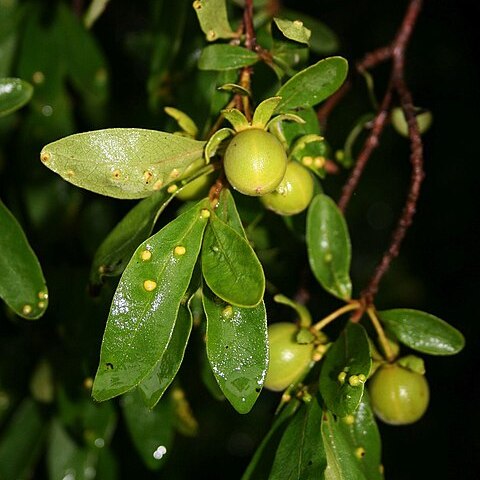Tree or shrub, 0.6-7.0 m high; branches leafy at tips. Leaves 18-80 x 5-30 mm, alternate, petiolate, oblanceolate to oblanceolate-obovate, coriaceous, glabrescent to sericeous. Bracts 2, on upper half of peduncle, linear, deciduous. Flowers female or functionally male; campanulate, pendulous, solitary, pubescent, cream-coloured, pink or red; stamens 10, reduced to staminodes in female flower; ovary on thin, glabrous disc. Flowering time Sept.-May. Fruit fleshy, green, yellow or red; drying smooth and hard, light brown. Seed dark brown, oblong, circumvented by oblique groove.
A shrub or small evergreen tree. It can be 3-7 m tall. The bark is dark grey and smooth. It can have several stems. There are 4 different types base on leaf shape and venation. The leaves are simple and alternate. They are leathery. They are usually crowded near the ends of branches. The flowers are bell-shaped. They are white or yellow. The flowers have a sweet smell and hand downwards. The fruit are round or oblong and 2 cm long. They are bright red and fleshy. The seeds are oblong and smooth with a groove along them. There are 2 subspecies.
Leaves chartaceous, drying dull dark brown or grey–green above, paler beneath; lamina 1·5 x 0·7–11 x 2·5 cm., obovate to oblanceolate, apex rounded to acute, base cuneate; lower surface sparsely to densely sericeous–pubescent, especially on the nerves; secondary nerves in 5–6 pairs.
Dioecious shrub or small tree, up to 7 m tall, with dark grey bark. Leaves shortly petiolate, oblanceolate, leathery, silky when young. Flowers solitary, axillary, creamy yellow, fragrant. Fruit a thinly hairy berry, yellow or red to brown.
Stamens 10, 0·3–0·45 cm. long; filaments very short, glabrous; anthers narrowly lanceolate, apiculate, densely setose with long hairs at base of connective and shorter hairs along its length on both surfaces.
Dioecious shrub or small tree to 7 m. Leaves shortly petiolate, oblanceolate, leathery, hairy when young. Flowers solitary, axillary, white to yellow, fragrant. Fruits thinly hairy, yellow or red to brown.
Ovary subglobose, ridged, 0·25 x 0·25 cm., tomentellous; locules 6, 8 or 10; styles (3–4)5, common style puberulous, branches glabrous, ending in a shallowly bi–lobed stigma.
Corolla up to 1 cm. long, campanulate, widely open at the throat, densely strigulose outside, lobed to just below the middle; lobes 5, ovate–oblong, obtuse.
Calyx up to 0·8 cm. long, densely sericeous–pubescent, deeply cleft almost to the base; lobes 5, narrowly deltate or lanceolate–acuminate.
Male flowers solitary, axillary or in axils of reduced leaves towards base of current year’s shoot; pedicels 0·7–1·7 cm. long.
Pistillode similar to functional gynoecium but rudimentary ovary conoidal and styles not bifid and stigmatic at the apex.
Fruit red, becoming black, ovoid or globose, apiculate, up to 2 x 1·5 cm., puberulous or glabrescent.
Fruiting calyx accrescent, up to 1·5 cm. long, lobes narrowly deltate, ultimately strongly reflexed.
Deciduous shrub or small tree up to 6 m. high, sometimes suffruticose.
Seeds 1–6 or more, brown, up to 1·3 cm. long; endosperm smooth.
Staminodes 10, 0·1–0·2 cm. long, densely setose.
Bole sometimes spinescent towards the base.
Female flowers similar to male.
Bark grey, ± smooth.


